Obon at Night
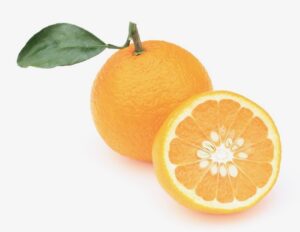
August 1stHa-ssaku, 八朔, eight-first day; the first day of August is called hassaku, which is actually a lunar event. Hassaku is also the name of a citrus fruit. The fruit is a hybrid of orange and grapefruit, and was discovered in the mid-19th century. It was declared by a Pure Land Buddhist priest that the fruit could be eaten on Hassaku, the first day of the eighth lunar month. The motivation seems obscure.
In Japan, the most important family observance of the year is O-bon, お盆, Hon.-tray, when departed spirits leave paradise, and return to their ancestral homes. Observances are held on various days and times. Traditionally, Obon is held in accord with the full moon during the seventh lunar month. The Buddhist deity of compassion who is honored monthly with the full moon is A-mi-da Nyorai, 阿弥陀如来, Praise-increase-steep Become-arrive.
O-bon is a contraction of U-ra-bon, 盂蘭盆, Bowl-orchid-tray, which is derived from the Sanskrit word ‘ullambana’, meaning ‘hanging upside down’. The Kanji ra also ran, 蘭, orchid, is also written with the Kanji, 蘭. The Kanji 蘭, without the grass radical, kusa, 艹, is the Kanji ran, 闌, rise high, well along. The Kanji is also read takeru, takenawa, tesuri, as in the height of summer, party, etc., in full swing. The word ‘takenawa’, is also written with the Kanji, 酣, with the same meanings. The Kanji is composed of sake and sweet. The Kanji ran/takenawa, 闌, is composed of mon, 門, gate, and kan, 柬, pick, choose, and/or tō, higashi, 東, east. The Kanji included with mon/gate makes considerable difference in the meaning.
An important event that is much loved in Japan is Tanabata, 七夕, Seven-night, which occurs on Shichi-gatsu nano-ka, 7月7日, 7 moon 7 day. Like Obon, Tanabata is held on various dates. Tanabata is also called the Hoshi Matsuri, 星祭, Star-festival, as the stars Altair and Vega are the subject of astrology and romance. In spite of the elaborate decorations, Tanabata is the start of seven days of purification preparing for Obon.
The principle feature of Tanabata are bamboo stalks that are decorated with strips of colored, light paper called tan-zaku, 短冊, short-volume, that bear written poems, wishes, and thanks
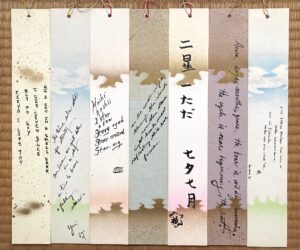
Group of several tan-zaku, 短冊, brief-volume, joined together to approximate a single sheet, saku, 冊. The tanzaku were written forty-some years ago by a group of friends at Cha-kai, 茶会, Tea-gathering, held on the night of Tanabata in a Teahut where I was living in Kyōto near Ginkakuji. The pictured tanzaku are made of heavy paper strips that were not intended to hang on the branches of bamboo. The reason that tanzaku are made of very light paper, is that the bamboo with its tanzaku and decorations is placed in a river to flow to the ocean and eventually join the Ama-no-kawa, 天の川, Heaven’s-river. The decorated bamboo should be made of natural materials that can return to nature. The printed, gilt pattern suggests that the paper is a single sheet with a continuous design. Such decorative, colored papers are part of the group of papers called shiki-shi, 色紙, color-paper.
The poems and prayers written on tanzaku, were originally written on a kaji no ha, 梶の葉, paper mulberry leaf. The inner bark of the kaji has been used in making paper in Japan for centuries. On the morning of the 7th day, dew is gathered from the leaves of the lotus or elephant ear plant to wet the suzuri, 硯, inkstone, for writing on the leaves or tanzaku. Dew, tsuyu, 露, comes from heaven, and is returned in the form of a prayer.
The meaning of tan-zaku, 短冊, short-volume: tan, 短, refers to a part of a larger document, such as a saku, 冊, which is approximated in the picture above. As traditional Japanese calligraphy is in vertical lines from right to left. Documents are folded into long narrow units. A single long narrow strip cut from the large paper becomes a ‘short’ volume.
A popular summer custom in Chanoyu, is the tea presentation called ha-buta, 葉蓋, leaf-lid, when a leaf is used as a lid on a slender mizu-sashi, 水指, water-indicate. The preferred leaf is the kaji no ha, 梶の葉, paper mulberry-leaf, although small lotus and taro leaves are used. Part of the stem should be retained to poke into the leaf when it is folded after use, and put into the ken-sui, 建水, build-water. Using a leaf to cover water began with Rikyū who placed a leaf over the water in the chō-zu-bachi, 手水鉢, hand-water-bowl, in the roji garden to protect it from the heat of the summer sun.
Gen-gen-sai, 玄々斎, Mystery-mystery-abstain, XI Iemoto of Urasenke, used the water and flower container of the sue-hiro kago, 末広籠, ends-wide basket, which is cylindrical mage-mono, 曲物, bent-thing, made of cedar. He had it lacquered black with patches of gold leaf, and used it as a mizusashi. Although followers of Chanoyu enjoy using Gengensai’s mizusashi, any suitable vessel may be used with the leaf.
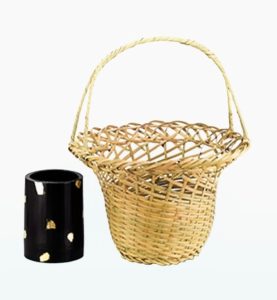
The suehiro kago is often used to display the aki no nana-kusa, 秋の七草, autumn’s seven-grasses, which begin to bloom in August. The aki no nanakusa have their counterpart in the haru no nana-kusa, 春の七草, spring’s seven-grasses. These are young nourishing herbs pounded, and eaten in a rice gruel, nana-kusa gayu, 七草粥, seven-grasses gruel, and eaten on the morning of the 7th day of the New Year.
In Kyōto, on August 16, 2023, is the wondrous event called Go-zan Okuri-bi, 五山送り火, Five Mountains Farewell-fires. Fires are meticulously set on the sides of five mountains around Kyōto, which help spirits return to paradise after their visit at their ancestral homes for Obon. The Bon farewell fire designs on the five mountains are:
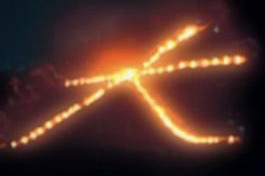
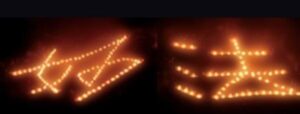
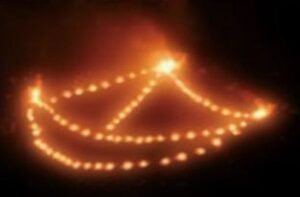
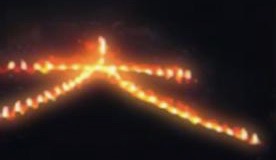

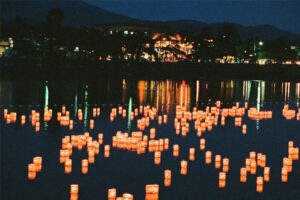
Tō-rō nagashi, 灯籠流し, lantern-basket flow: candle-lit papered lantern ‘floats’ drift on the Katsura Gawa, 桂川, Katsura River, in western Kyōto. Tōrō nagashi is as aspect of Obon okuri-bi, 送り火, farewell-fires, that aid spirits to return to paradise.
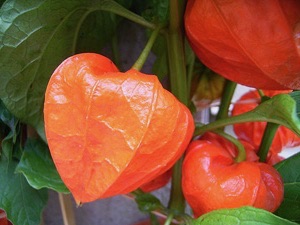
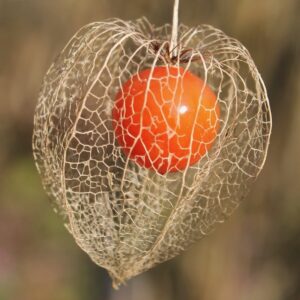
Hōzuki, ホオズキ(ナス科)酸漿, ground cherry (Physalis alkekengi var. franchetii); husk tomato; Chinese lantern plant, bladder cherry, etc. The hōzuki is a member of the nasu-ka, ナス科, (eggplant)-department, Solanaceae, nightshade family of plants.
The fruit of the hōzuki is made into a variety of comestibles often including sugar, like jam, and to make a kind of tea. The dried fruits and roots of the hōzuki are popular in shō-yaku, 生薬, life-medicine, nature remedy named ‘san-shō–kan’, 酸漿根, sour-drink-root. It is used as a cough suppressant, antipyretic, and diuretic to treat fever, jaundice, and edema. Sanshō can be taken daily in small doses mixed with water. Pregnant women should not take this medicine as it can cause an abortion.
The cherry is made into a toy called a hōzuki no fue, ホウズキの笛, cherry ’s flute. The seeds and pulp of the fruit are taken out to create a hollow ‘bladder’, which is held in front of the lips and blown across to make it whistle. Emptying it and making it whistle is more challenging than one might think.
For further study, see also: Tea in August, Tea in July, August Tea Presentation, Cha茶月Tsuki

